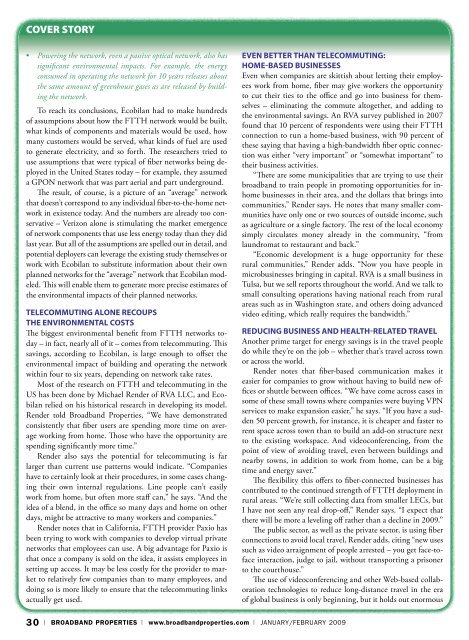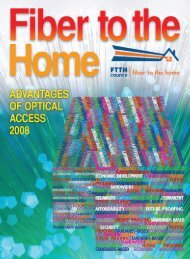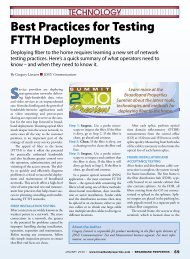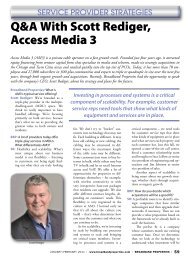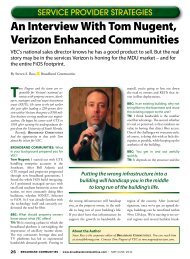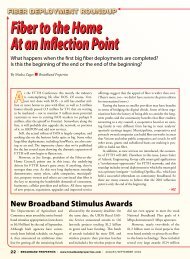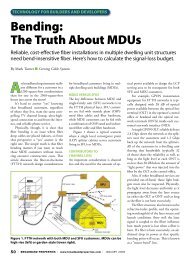bbpmag.com - Broadband Properties
bbpmag.com - Broadband Properties
bbpmag.com - Broadband Properties
You also want an ePaper? Increase the reach of your titles
YUMPU automatically turns print PDFs into web optimized ePapers that Google loves.
Cover Story<br />
• Powering the network, even a passive optical network, also has<br />
significant environmental impacts. For example, the energy<br />
consumed in operating the network for 10 years releases about<br />
the same amount of greenhouse gases as are released by building<br />
the network.<br />
To reach its conclusions, Ecobilan had to make hundreds<br />
of assumptions about how the FTTH network would be built,<br />
what kinds of <strong>com</strong>ponents and materials would be used, how<br />
many customers would be served, what kinds of fuel are used<br />
to generate electricity, and so forth. The researchers tried to<br />
use assumptions that were typical of fiber networks being deployed<br />
in the United States today – for example, they assumed<br />
a GPON network that was part aerial and part underground.<br />
The result, of course, is a picture of an “average” network<br />
that doesn’t correspond to any individual fiber-to-the-home network<br />
in existence today. And the numbers are already too conservative<br />
– Verizon alone is stimulating the market emergence<br />
of network <strong>com</strong>ponents that use less energy today than they did<br />
last year. But all of the assumptions are spelled out in detail, and<br />
potential deployers can leverage the existing study themselves or<br />
work with Ecobilan to substitute information about their own<br />
planned networks for the “average” network that Ecobilan modeled.<br />
This will enable them to generate more precise estimates of<br />
the environmental impacts of their planned networks.<br />
Tele<strong>com</strong>muting Alone Recoups<br />
the Environmental Costs<br />
The biggest environmental benefit from FTTH networks today<br />
– in fact, nearly all of it – <strong>com</strong>es from tele<strong>com</strong>muting. This<br />
savings, according to Ecobilan, is large enough to offset the<br />
environmental impact of building and operating the network<br />
within four to six years, depending on network take rates.<br />
Most of the research on FTTH and tele<strong>com</strong>muting in the<br />
US has been done by Michael Render of RVA LLC, and Ecobilan<br />
relied on his historical research in developing its model.<br />
Render told <strong>Broadband</strong> <strong>Properties</strong>, “We have demonstrated<br />
consistently that fiber users are spending more time on average<br />
working from home. Those who have the opportunity are<br />
spending significantly more time.”<br />
Render also says the potential for tele<strong>com</strong>muting is far<br />
larger than current use patterns would indicate. “Companies<br />
have to certainly look at their procedures, in some cases changing<br />
their own internal regulations. Line people can’t easily<br />
work from home, but often more staff can,” he says. “And the<br />
idea of a blend, in the office so many days and home on other<br />
days, might be attractive to many workers and <strong>com</strong>panies.”<br />
Render notes that in California, FTTH provider Paxio has<br />
been trying to work with <strong>com</strong>panies to develop virtual private<br />
networks that employees can use. A big advantage for Paxio is<br />
that once a <strong>com</strong>pany is sold on the idea, it assists employees in<br />
setting up access. It may be less costly for the provider to market<br />
to relatively few <strong>com</strong>panies than to many employees, and<br />
doing so is more likely to ensure that the tele<strong>com</strong>muting links<br />
actually get used.<br />
Even Better Than Tele<strong>com</strong>muting:<br />
Home-Based Businesses<br />
Even when <strong>com</strong>panies are skittish about letting their employees<br />
work from home, fiber may give workers the opportunity<br />
to cut their ties to the office and go into business for themselves<br />
– eliminating the <strong>com</strong>mute altogether, and adding to<br />
the environmental savings. An RVA survey published in 2007<br />
found that 10 percent of respondents were using their FTTH<br />
connection to run a home-based business, with 90 percent of<br />
these saying that having a high-bandwidth fiber optic connection<br />
was either “very important” or “somewhat important” to<br />
their business activities.<br />
“There are some municipalities that are trying to use their<br />
broadband to train people in promoting opportunities for inhome<br />
businesses in their area, and the dollars that brings into<br />
<strong>com</strong>munities,” Render says. He notes that many smaller <strong>com</strong>munities<br />
have only one or two sources of outside in<strong>com</strong>e, such<br />
as agriculture or a single factory. The rest of the local economy<br />
simply circulates money already in the <strong>com</strong>munity, “from<br />
laundromat to restaurant and back.”<br />
“Economic development is a huge opportunity for these<br />
rural <strong>com</strong>munities,” Render adds. “Now you have people in<br />
microbusinesses bringing in capital. RVA is a small business in<br />
Tulsa, but we sell reports throughout the world. And we talk to<br />
small consulting operations having national reach from rural<br />
areas such as in Washington state, and others doing advanced<br />
video editing, which really requires the bandwidth.”<br />
Reducing Business and Health-Related Travel<br />
Another prime target for energy savings is in the travel people<br />
do while they’re on the job – whether that’s travel across town<br />
or across the world.<br />
Render notes that fiber-based <strong>com</strong>munication makes it<br />
easier for <strong>com</strong>panies to grow without having to build new offices<br />
or shuttle between offices. “We have <strong>com</strong>e across cases in<br />
some of these small towns where <strong>com</strong>panies were buying VPN<br />
services to make expansion easier,” he says. “If you have a sudden<br />
50 percent growth, for instance, it is cheaper and faster to<br />
rent space across town than to build an add-on structure next<br />
to the existing workspace. And videoconferencing, from the<br />
point of view of avoiding travel, even between buildings and<br />
nearby towns, in addition to work from home, can be a big<br />
time and energy saver.”<br />
The flexibility this offers to fiber-connected businesses has<br />
contributed to the continued strength of FTTH deployment in<br />
rural areas. “We’re still collecting data from smaller LECs, but<br />
I have not seen any real drop-off,” Render says. “I expect that<br />
there will be more a leveling off rather than a decline in 2009.”<br />
The public sector, as well as the private sector, is using fiber<br />
connections to avoid local travel, Render adds, citing “new uses<br />
such as video arraignment of people arrested – you get face-toface<br />
interaction, judge to jail, without transporting a prisoner<br />
to the courthouse.”<br />
The use of videoconferencing and other Web-based collaboration<br />
technologies to reduce long-distance travel in the era<br />
of global business is only beginning, but it holds out enormous<br />
30 | BROADBAND PROPERTIES | www.broadbandproperties.<strong>com</strong> | January/February 2009


